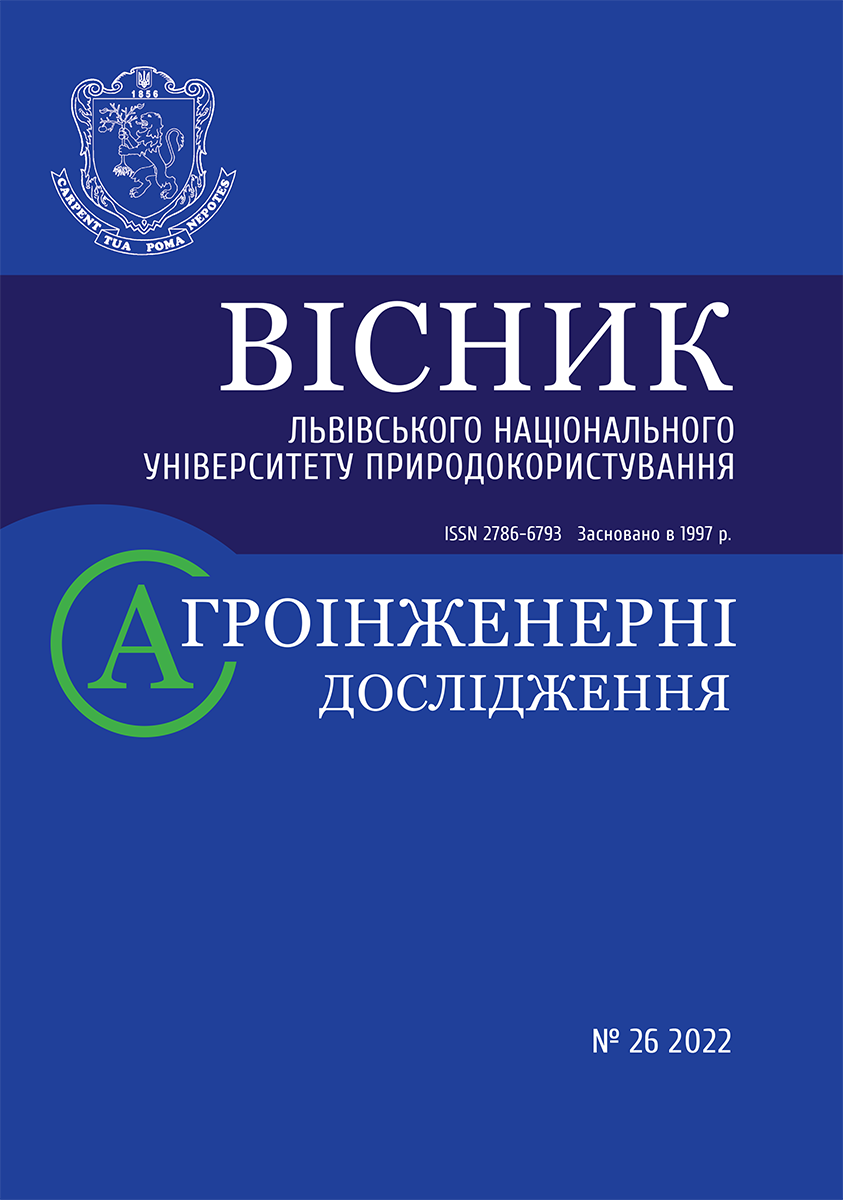Justification of the parameters and operation modes of a thermal accumulator with a solid accumulative material of a porous structure for heliothermal installations
DOI:
https://doi.org/10.31734/agroengineering2022.26.077Keywords:
heat accumulator, heat and mass exchange, heliothermal installationAbstract
A new type of battery with a solid heat-accumulating material of a porous structure has been developed for a heliothermal installation, which is based on the use of an environmentally friendly and renewable source of thermal energy - solar radiation and accumulated heat.
The structural and technological scheme of the plug-in heat accumulator using pebbles was substantiated and its modes of operation were analyzed. In order to evaluate the battery efficiency, the following factors are determined, in particular, the spectral composition of the absorbed radiation that determines the rate of pebbles heating, organization of the radiation field due to the control of the the coolant flow, properties of the material under study and the leakage of the medium, changes in the conditions of heat exchange, geometric parameters of the battery.
A mathematical model was obtained. It can be used to calculate the amount of absorption of the temperature gradient in the conditions of a stationary porous layer of pebbles and to regulate the depth of heat flow penetration for a specific layer of the battery in which phase transformations take place.
A method of engineering calculation of thermal fields for a stationary porous layer of pebbles and recommendations for their successful use in a heliothermal installation to ensure its operation at night and in partly cloudy conditions are proposed. The choice of such heat-accumulating elements was based on the study of the heat flow in the porous layer and the energy of convective heat exchange. It was established that a layer of pebbles with a porous structure is the most promising in terms of its use as a solar radiation accumulator in the temperature regime of 30...50 ºС. By using the layer, the energy supplied to the heat accumulator was 615.4 kJ, and the heating of the heat-accumulating material with the weight of 50 kg per 1 ºС made it possible to accumulate 42.25 kJ/ºС of heat.
References
Enerhetychna stratehiia Ukrainy na period do 2035 roku. Bila knyha enerhetychnoi polityky Ukrainy «Bezpeka ta konkurentnospromizhnist» (2015). Kyiv.
Janjai, S., Phusampao, C., Nilnont, W., Pankaew, P., &Janjai, S. (2014). Experimental performance and modeling of a greenhouse solar dryer for drying macadamia nuts. International Journal of Scientific & Engineering Research, 5, 1155-1161.
Kaveh, M., Amiri Chayjan, R., & Esna-Ashari, M. (2015). Thermal and physical properties modelling of terebinth fruit under solar drying. Research in Agricultural Engineering, 61 (4), 150−161. doi: 10.17221/45/2013-RAE.
Khazimov, Z. M., Bora, G. C., Khazimov, K. M., & Khazimov, M. Z. (2014). Modeling of the motion of free convective drying agent in plastic helio dryer. Journal of Engineering Thermophysics, 23(4), 306−315. doi: 10.1134/S1810232814040080.
Kituu, G. M., Shitanda, D. R., Kanali, C. L., & Mailutha, J. T. (2010). Thin layer drying model for simulating the drying of tilapia fish in a solar tunnel dryer. Journal of Food Engineering, 98 (3), 325−331. doi: 10.1016/j.jfoodeng.2010.01.009.
Korobka, S., Babych, M. (2017). Substatiation of the constructive-technologocal parameters of a solar fruit dryer. Eastern-European Journal of Enterprise Technologies, 1(8 (85)), 13-19.
Korobka, S., Babych, M., Krygul, R., & Zdobytskyj, A. (2018). Results of research into technological process of fruit drying in the solar. Eastern-European Journal of Enterprise Technologies, 1/8(91), 64-73.
Manoj, M., Manivaimair, A. (2013). Simulation of solar dryer utilizing green house effect for cocoa bean drying. International Journal of Advanced Engineering Technology, 4 (2). Retrieved from http://www.technicaljournalsonline.com/ijeat/VOL%20IV/IJAET%20VOL%20IV%20ISSUE%20II%20APRIL%20JUNE%202013/Vol%20IV%20Issue%20II%20Article%207.pdf.
Misha, S., Mat, S., Ruslan, M. H., Sopian, K., & Salleh, E. (2013). Review on the Application of a Tray Dryer System for Agricultural Products. World Applied Sciences Journal, 22, 3, 424−433. doi: 10.5829/idosi.wasj.2013.22.03.343.
Mohanraj, M., & Chandrasekar, P. (2009). Performance of a forced convection solar drier integrated with gravel as heat storage for chili drying. Journal of Engineering Science аnd Technology, 4, 3. Retrieved from https://www.researchgate.net/publication/49593948_Performance_of_a_forced_convection_solar_drier_integrated_with_gravel_as_heat_storage_material.
NASA Surface meteorology and Solar Energy. Retrieved from http://eosweb.larc.nasa.gov/cgibin/sse/grid/cgi?uid=3030.
Sazhin, B. N. (1984). Osnovy tekhniki sushki: Ucheb. posobye. Moskva: Khimiya.
Shargut, Ya. V., & Petela, R. Y. (1968). Eksergyia: Ucheb. posobye. Moskva: Energyia.
Urmashev, B. A., Danaev, N. T., & Darybaev, B. S. (2012). On a Problem of Thermal Convection with Unset Flow Rate. In IECMSA-2012: 1st International Eurasian Conference on Mathematical Sciences and Applications. Prishtine.
Yermuratskiy, V. V., Yermuratskiy, V. V., & Yermuratskiy, P. V. (2015). Effektivnost primeneniya ploskikh reflektorov v gelíoustanovkakh. Vestnik Institutu energetiki AN Moldovy. Problemy regionalnoy energetiki, 1, 1-6.


